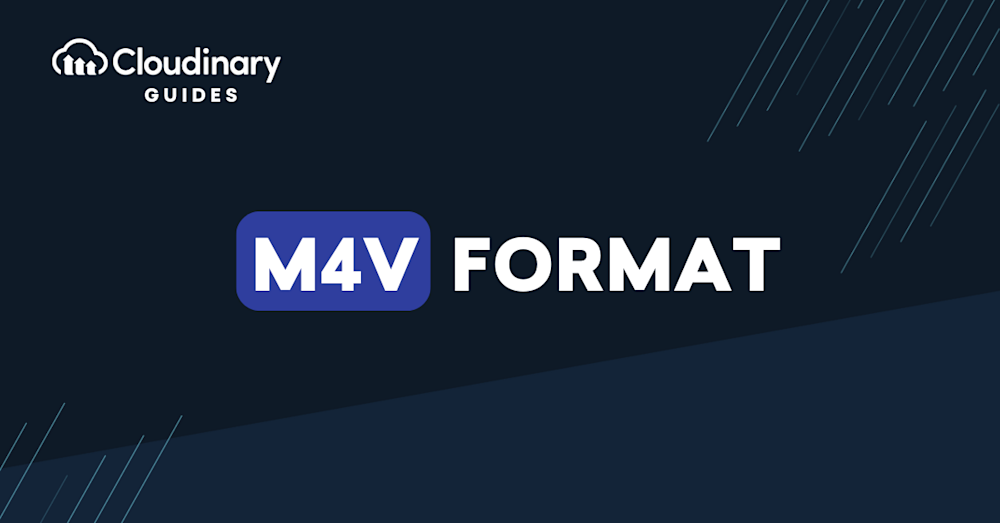What Is the M4V Format?
M4V is a container video format developed by Apple, closely resembling the MP4 format. The main difference between M4V and MP4 is that an M4V file can enjoy DRM copy protection. This DRM protection is in place to prevent piracy, ensuring that M4V files purchased from the iTunes store cannot play on non-Apple players.
Apple encodes video files in the iTunes Store using M4V. Apple FairPlay offers copy protection to prevent the unauthorized reproduction of M4V video files. FairPlay-protected M4V files are only playable on authorized devices, based on the iTunes account that purchased the videos—QuickTime identifies M4V files with FairPlay DRM as AVC0 Media.
In this article:
How to Open M4V Format Files
You cannot view DRM-protected M4V files without permission from the iTunes account that purchased the file. To access an iTunes account, the user will need to log in with the Apple ID they received when they first signed up for the service.
DRM-protected M4V files can only be purchased from or played on the iTunes app on iOS devices such as an iPhone, iPad, or iPod Touch. Non-protected M4V files can also be played by third-party applications and non-iOS platforms. This includes software like Windows Media Player, VLC, and of course, QuickTime.
On a Windows-based PC, it is usually possible to play M4V files via the default Windows Media Player. There are many free players available, including the Apple QuickTime player. Google Drive supports playing M4V files directly from cloud storage. Another option is to change the file extension from .m4v to .mp4, which allows the file to be played on most standard MP4 media players.
M4V File Format Structure
The MPEG-4 format’s specification is based on QuickTime’s specification.
An M4V file comprises several consecutive chunks. Every chunk has an 8-byte header, including a chunk size (4-byte) and chunk type (4-byte). The first chunk is always “ftype” with a subtype at offset 8. The subtype defining M4V is “M4V_.”
The remaining chunks can have predefined signatures with the following types: ftyp, mdat, moov, pnot, udta, uuid, moof, free, skip, jP2, wide, load, ctab, imap, matt, kmat, clip, crgn, sync, chap, tmcd, scpt, ssrc, or PICT.
The system iterates chunks until it detects an unknown type, composing the M4V file.
When inspecting the binary data of an M4V using a Hex Viewer (e.g., Active@ Disk Editor), it will start with a “ftyp” signature (hex: 66 74 79 70) at offset 4. This defines the QuickTime container file type.
File subtype—M4V_ (hex: 4D 34 56 20)—points to the M4V (or MPEG-4) file type. The first block’s size is 32 (hex: 00 00 00 20), with the size at offset 0. The second chunk is at offset 32 (hex: 20), its size is 30,322 (hex: 00 00 76 72), and its type is “moov” (hex: 6D 6F 6F 76).
The third chunk is at offset 32+30, 322=30, 354 (hex: 00 00 76 92), its size is 8 (hex: 00 00 00 08), and its type is “free”(hex: 66 72 65 65).
Continuing to iterate the blocks allows you to collect all the M4V file’s data.
Codecs used by M4V:
- Video codec—M4V uses H.264, a video compression standard that converts digital video to a format that requires less transmission bandwidth or storage space, and is supported by many DVD, television, and videoconferencing applications.
- Audio codec—M4V uses Advanced Audio Coding (AAC), an audio codec for one-way digital audio compression. AAC is the successor to the MP3 format and offers better quality than MP3 at the same bitrate. It deletes some information during compression, but usually with no significant impact on audio. AAC is a variable bit rate (VBR) block-based codec.
M4V vs MP4
MP4 is a similar container format that supports audio and visual data and complementary data like subtitles. MP4 is short for MPEG-4 Part 14. A wide range of devices and media players support the .mp4 extension. This format also enables online streaming. This file format is therefore popular for various video functions. However, MP4 files do not benefit from DRM protection, making them suitable for widely-shared or public media that can be exposed to anyone.
The codec is a major difference when choosing the video file format. MP4 files can contain MPEG-4, H.264, and HEVC files, while M4V files only support the H.264 codec (there is no other way to create this file type). There is a negligible difference in video quality between MP4 and M4V, but encoding with H.264 requires more data, often resulting in very large files. Depending on where you write or store the files, this data usage can impact the user experience.
Another issue to consider when comparing the MP4 and M4V formats is compatibility, which is often a top priority for consumers. In a direct comparison of the number of programs and devices supporting each file format, it is clear that .mp4 is a much more widespread file extension. Both Mac and Windows devices and applications can read MP4 files.
However, M4V files are comparatively restricted, which is why they are sometimes called “iTunes M4V”—their original purpose was for Apple software. QuickTime players can read M4V files, but Android and Windows devices may require installing special software to play M4V video files. Another option is to convert an M4V file to another format the device supports.
For most users, the differences between M4V and MP4 are negligible. It doesn’t matter which format you use if you don’t need to protect your video content or add subtitles. M4V files are slightly less accessible because the format is less widespread, but they benefit from strong copy protection. Adding subtitles and other supporting data to M4V videos is also easy.
MP4 may be a good choice to maximize your video’s accessibility. These files are easy to share, download, and edit. Given the popularity of MP4, users are unlikely to have to install additional software to view it. Additionally, MP4 files are one of the more common video file formats used for downloading and streaming videos from the internet, making them a versatile choice for various video functions.
Related content: Read our guide to converting video formats
How Do You Convert M4V to MP4 Or WebM Format With Cloudinary?
The M4V format is less common than MP4, and has less advanced compression than advanced formats like WebM. Cloudinary can help you automatically convert M4V files to modern video formats for faster loading, and an enhanced user experience.
Cloudinary performs the task in the cloud through automation in three steps:
- Convert M4V to MP4s or WebM through dynamic URLs.
- Resize, crop, and transform the videos generated in step 1.
- Optimize the transformed videos through a fast content delivery network (CDN).
The conversion capability is available in all Cloudinary plans, including the free tier. Do check it out.


